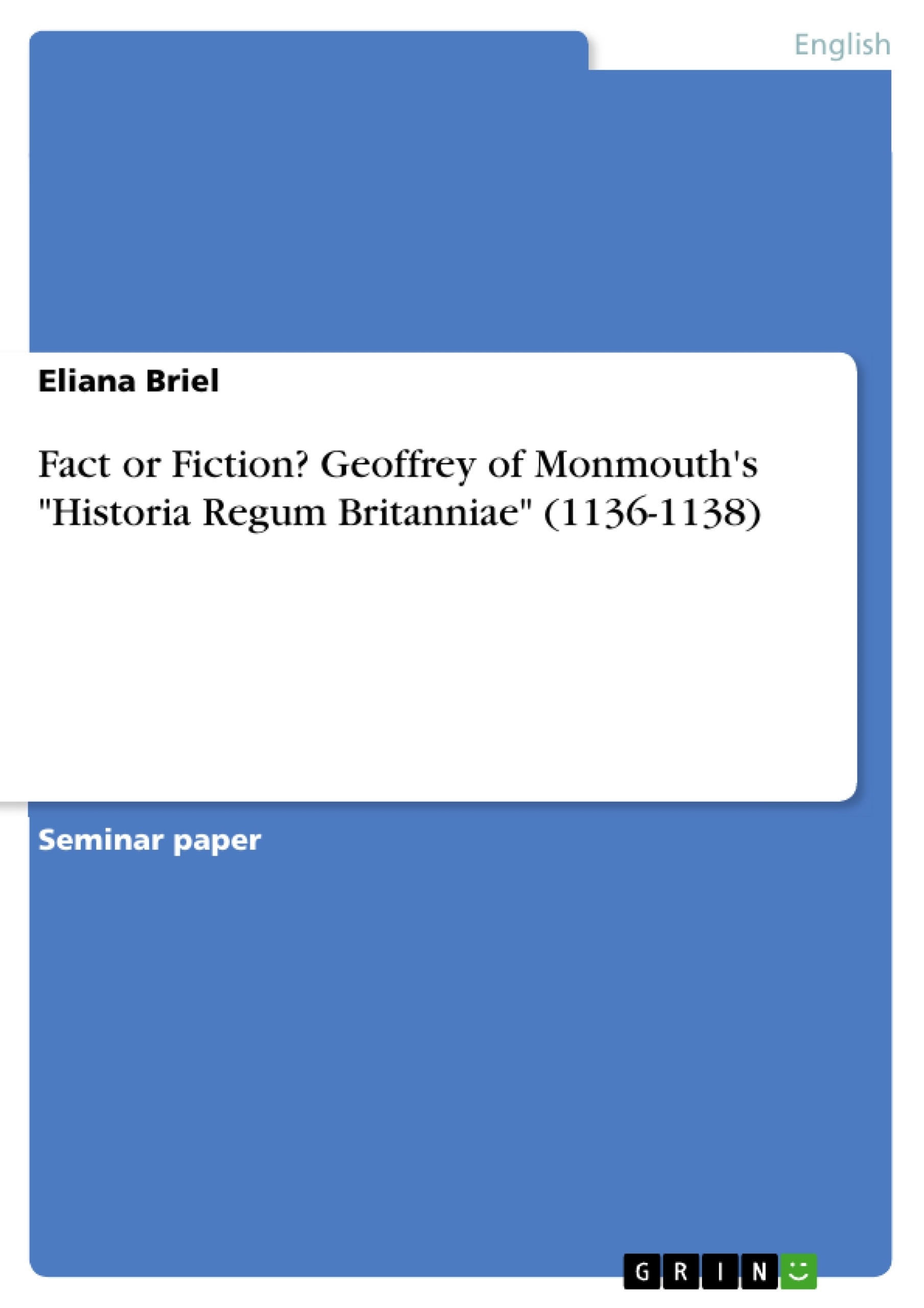"König Artus lebt!" As the title of Stefan Zimmer’s book illustrates, the fame of the English myth around King Arthur and his deeds seem to be as alive today as when his first reports appeared. The vast literary canon connected to the Arthurian legend alone proves its omnipresence and importance. Arthur’s merits are primarily known thanks to Geoffrey of Monmouth (~1100-1155), one of “the Fathers of Arthurian literature”, who published his Latin best-seller Historia Regum Britanniae, the History of the Kings of Britain, in the Anglo-Norman period, between 1136 and 1138. Another major milestone in connection with Arthur is “the discovery of Arthur’s remains at Glastonbury Abbey, in 1191.” Those twelfth century events contributed to Arthur’s popularity and had “[…] such an impact on contemporary minds that Arthur acquired a reality and a dimension that he had never had before”.
This paper focuses on Geoffrey of Monmouth’s literary legacy. Little is certain about Geoffrey of Monmouth’s life and even the scarce details that exist are not necessarily reliable. He probably originated from Monmouth and thus paid homage to his birthplace through his name. Geoffrey’s exact date of birth is unknown, but some sources suggest that he died in 1155. Interestingly, he used his father’s name, Arthur, at the beginning of his career . Therefore, his alias already showed a link to the legend of the famous warrior king, he later on wrote about. Geoffrey was ordained bishop in Saint Asaph and Lambeth and taught as magister at Oxford . Moreover, Geoffrey was said to be part British, because he paints a positive image of the Bretons in his Historia. His literary career was based on three major works: The Prophecies of Merlin, The History of the Kings of Britain, and The Life of Merlin, which he later on incorporated in his Historia. Whether Geoffrey wrote parts of the Book of Llandaff is still an ongoing debate . By all means, the Historia’s reputation made it known as one of the most important books of the Middle Ages.
Table of Contents
- Introduction
- Historia Regum Britanniae (1136-1138) - a true account?
- Geoffrey of Monmouth's motivation and his sources
Objectives and Key Themes
This paper explores the historicity of Geoffrey of Monmouth's Historia Regum Britanniae. The main objective is to determine the extent to which the work can be considered trustworthy historiography and, conversely, how it functions as fiction. The paper examines Geoffrey's motivation for writing the Historia, analyzes his sources, and investigates how he shapes the Arthurian legend. Ultimately, it aims to assess the credibility of the Historia in the context of its historical and literary significance.- Geoffrey's motivation for writing the Historia
- The sources he utilizes
- The shaping of the Arthurian legend within the Historia
- Elements that support the Historia's historical credibility
- Criticisms of the Historia as fiction
Chapter Summaries
Introduction
This chapter provides a brief overview of the Arthurian legend, highlighting its enduring popularity and the significant role played by Geoffrey of Monmouth. It emphasizes the enduring impact of his Historia Regum Britanniae, which shaped the understanding of King Arthur for centuries. The chapter also presents a brief biographical sketch of Geoffrey of Monmouth, highlighting his background, career, and literary accomplishments.Historia Regum Britanniae (1136-1138) - a true account?
This chapter introduces the central question of the paper: to what extent can Geoffrey's Historia be considered a reliable historical account. It outlines the methodology of the investigation, focusing on analyzing the arguments for and against the work's historicity. The chapter also examines Geoffrey's purpose in writing the Historia and the sources he employed in constructing his narrative.Geoffrey of Monmouth's motivation and his sources
This chapter delves deeper into the motivations behind Geoffrey's writing of the Historia. It explores the historical context, including the political climate and the role of Britain in the world at the time. The chapter examines various interpretations of Geoffrey's intentions, including the possibility of promoting a sense of national pride and asserting Britain's dominance over France. It also analyzes the sources that Geoffrey drew upon, highlighting his reliance on the Historia Brittonum, the works of Bede and Gildas, and other historical and mythological sources. The chapter further examines the role of Walter, Archdeacon of Oxford, and the mysterious "ancient book in the British language" that Geoffrey claimed to have translated.- Arbeit zitieren
- Eliana Briel (Autor:in), 2012, Fact or Fiction? Geoffrey of Monmouth's "Historia Regum Britanniae" (1136-1138), München, GRIN Verlag, https://www.grin.com/document/287925



